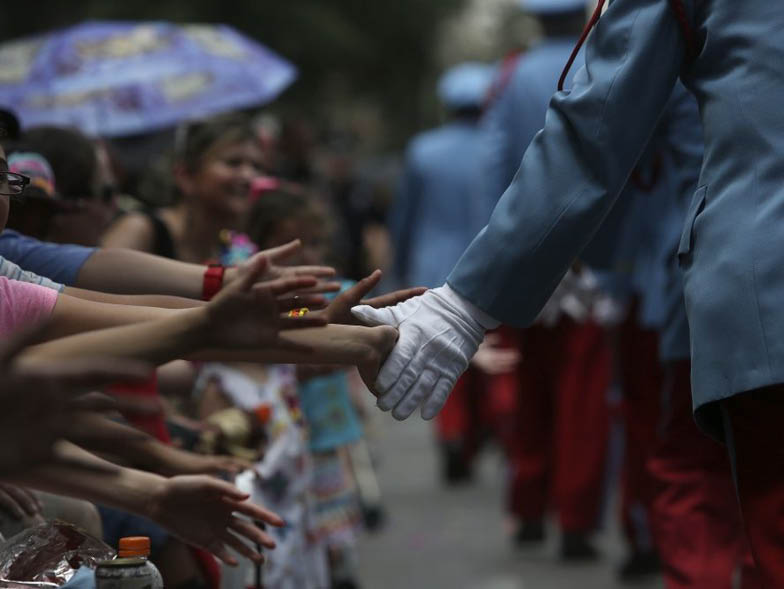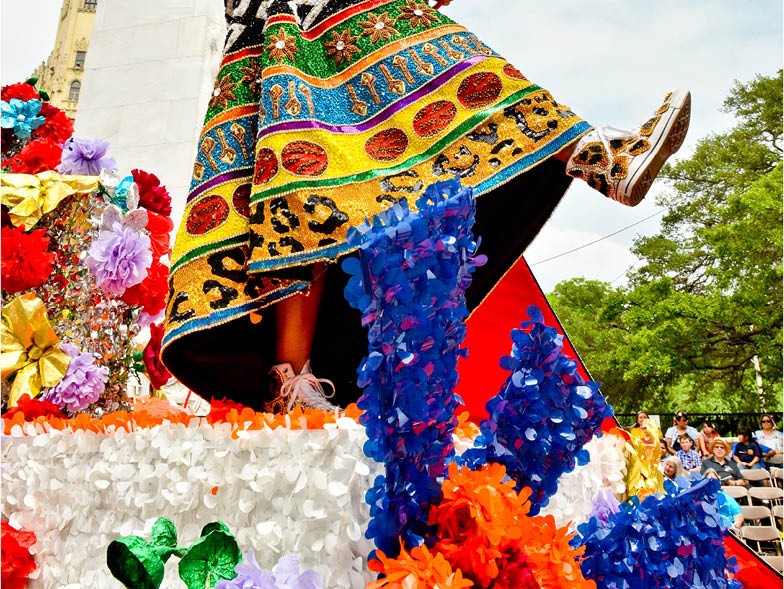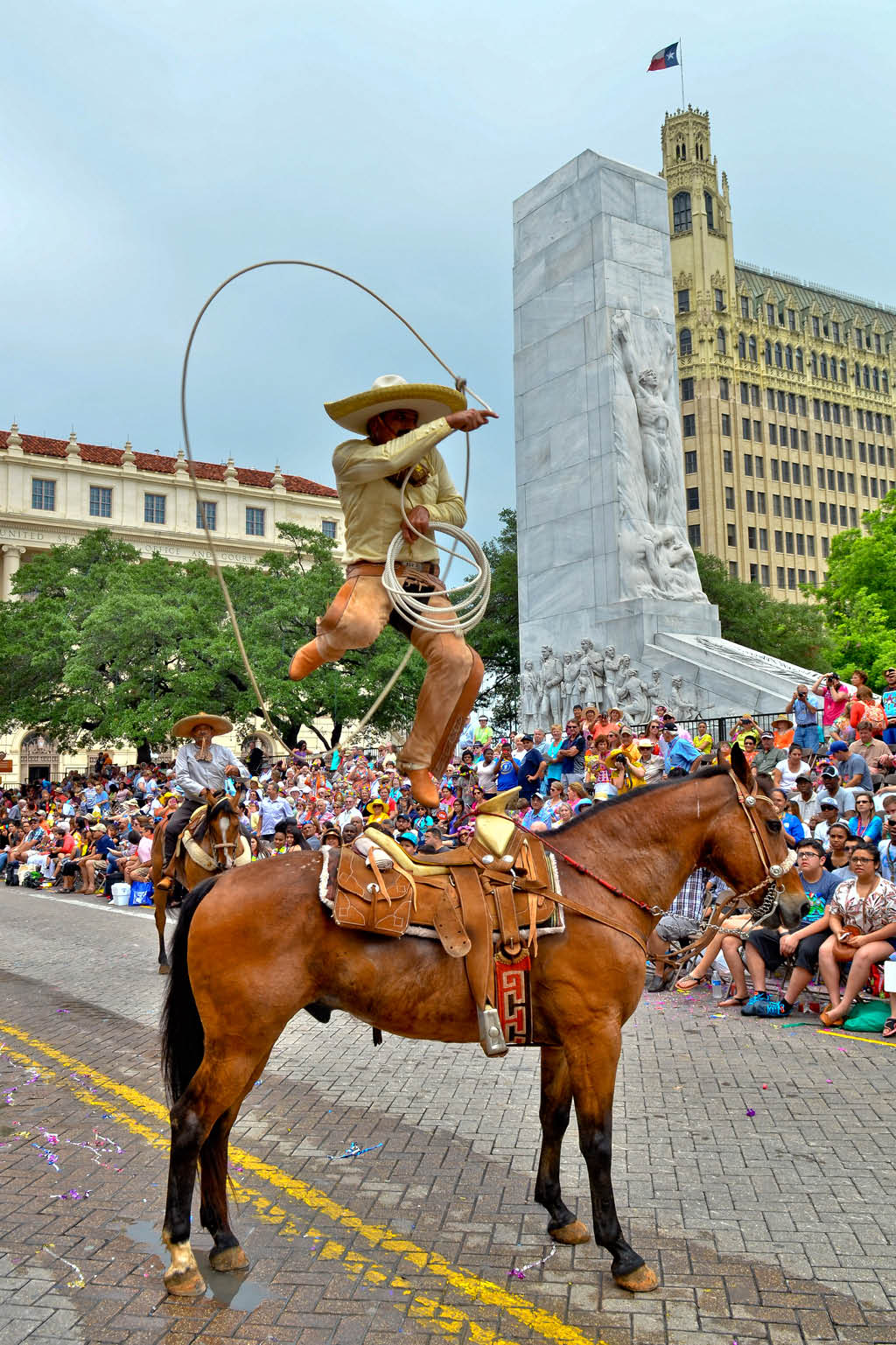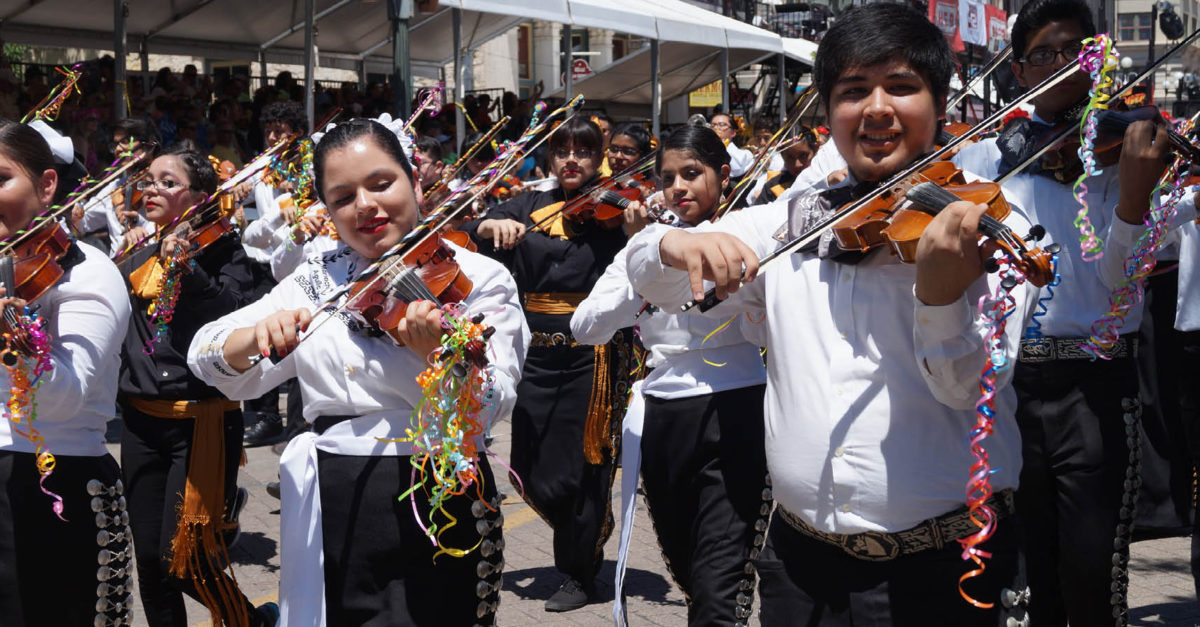Texas on Parade
The Battle of Flowers Parade is an annual tradition that attracts hundreds of thousands of revelers to downtown San Antonio, Texas, to celebrate the city and state and to honor the history of the Alamo. Its 2016 parade chair, Anna-Laura Howell Block, gives us a behind-the-scenes look at this dynamic yet poignant parade that features flower-covered floats, colorful costumes, beautiful gowns, marching bands, military cavalcades, horse-drawn carriages, and antique cars—as well as the special events that helped to commemorate its 125th anniversary.
This grand celebration started in 1891. A congressman’s wife, Ellen Maury Slayden, had seen a flower parade in Spain and suggested having one to commemorate the Battle at San Jacinto—through which Texas won its independence from Mexico—as well as the fallen heroes of the Alamo. It was actually scheduled for April 21, the date of the Battle of San Jacinto, but it was moved up a day because president Benjamin Harrison was in town to give a speech. However, the parade was delayed to April 24 because it rained like cats and dogs for days.
Undaunted, Mrs. Slayden and her friends got together at the Alamo and staged this big, spectacular event: the revelers faced each other in carriages, advanced, and pelted each other with flowers. They did that for a solid hour! Over 10,000 residents (a quarter of the population at the time) lined the downtown streets of San Antonio to watch this parade—or, as it came to be known, the Battle of Flowers.

The parade grew quickly after it debuted, and it became an annual tradition. By 1895, it was a weeklong event, and the first parade queen was crowned; in 1916, we crowned our first king (dubbed King Antonio) as well. An oratorical contest, which encourages students to write about
Texas history, debuted in 1926, and a band festival was added in 1935. By 1959, the event was so big that it was renamed Fiesta San Antonio, which today is an annual ten-day event celebrating the city and its history and features parades, amusements, coronation events, and musical performances. But, at the heart of it all, as it was from the very beginning, is the Battle of Flowers Parade.
Today, the Battle of Flowers is a huge event—in fact, it’s the biggest parade in the nation put on entirely by women volunteers, who make up the Battle of Flowers Association, and it’s the second- largest day parade in the US. It’s an amazing event; the whole city stops. All the local schools are closed so kids can go to the parade with their families. Approximately 350,000 people attend the
parade in person, and three-and-a-half to four million people view it on TV in both Spanish and English. The parade is 2.6 miles long, and it takes about an hour and ten minutes of marching time down Broadway Street. And it goes on rain or shine—the parade has never been canceled because of the weather, though it was paused during World War I and World War II.
Being over a century old, it’s an event that is steeped in many wonderful traditions. One of the most poignant is the floral tribute at the Alamo, which means so much to our city and who we are. When parade participants arrive at the Alamo, they each lay a fresh flower, bouquet, or wreath on the lawn in front of the building. To see them laying the flowers down as a tribute to the fallen heroes is always very solemn. All of the parade participants are having fun, but when they pause at the Alamo, the tone becomes somber. Everyone at the parade gets goose bumps. We all know what it means, and that’s why we’re here. Once they proceed past the memorial, though, they resume the merriment. A big part of the merriment is collecting medals, a tradition that’s been going on for decades during Fiesta. Much like stockpiling beads at Mardi Gras, San Antonians try to collect as many medals as possible.
People here love medals (San Antonio is considered Military City, USA, after all), and it’s always a way to get the word out about fundraisers, schools, and so forth. Everybody does it, including me. Every year for the past twenty years, I’ve made 3,000 medals and handed them out at the parade. Personally, I love collecting medals, too—I am a three-time champion collector, and I have over 10,000 in all.

But there was even more meaning behind the medals last year. For the 2016 parade, we had a fantastic ten-foot display of the Alamo built out of wood. The front of it had 600 hooks, so, in addition to handing over their fresh floral tributes as they passed the building, the participants also handed over medals to hang on the display. It was a new spin on things, and I hope it will be a new tradition coupled with the old floral tribute.
Perhaps the most visible tradition is the Battle of Flowers Association ladies wearing yellow dresses and yellow hats. The association was formed way back in 1914, but in 1976, our president, Edith Sethness, felt that it would be good for all of the members to color coordinate so people could easily identify the Battle of Flowers members at the parade, and yellow was her favorite color. Everyone certainly knows who we are at the parade!
You will also easily recognize our royalty section. Every year, the young ladies—duchesses, the parade princess, and the parade queen—are on the float wearing very elaborate gowns with long trains. What’s unique about the Battle of Flowers, though, is that the crowd will shout, “Show us your shoes!” and the ladies will pull up their dresses to reveal their cowboy boots. It’s a fun tradition, but it’s also symbolic—no matter who you are or what you do, the heart of Texas is underneath.

That sentiment is exactly what I wanted to celebrate in a big way for our 125th anniversary. As parade chair in 2016, it was my job to come up with the overarching theme for the parade and the themes to use under it for everyone to choose from for their antique cars, carriages, wagons, and floats. Since it was our 125th celebration, I thought an appropriate theme was “Texas Traditions . . . 125 Years.”
In choosing this, I tried to give a nod to all things Texas, like tubing, fishing, and camping. We also represented traditional Texas music legends (such as Chuck Berry, George Strait, Janis Joplin, Kenny Rogers, Willie Nelson, Roy Orbison, and ZZ Top) and Texas icons (like Stephen F. Austin and Sam Houston) on floats. Other themes included traditional Texas humor (like a big mosquito carrying a man away), traditional Texas critters (like a jackalope and a longhorn), and traditional Texas festivals and folk art. I also made sure to celebrate traditional southern culture, because San Antonio is a melting pot of so many diverse cultures and people. Participants could choose to honor Spanish culture, German culture, Canary Islands culture, and so forth—anything that celebrated typically southern heritages.
Also, because the military has always been such a big part of San Antonio and our parade, we incorporated the military in a way that would be memorable for both the military members and the spectators. In addition to the ROTC performing drills preceding the festivities and military members marching in the parade and being honored on a big float—as is the case every year—the military also helped usher in our parade’s 125th birthday in spectacular fashion: the Blue Angels did a flyover down the entire parade route after the ribbon-cutting ceremony! It was quite a way to kick off the parade—the crowd loved it!

We had countless other firsts for our 125th anniversary, too. We’ve had well-known people as grand marshals over our history, including Laura Bush, Lady Bird Johnson (twice), and actor Armie Hammer.
However, in 2016, we had two women grand marshals riding in the parade for the first time. The grand marshal was ninety-one-year-old Rosemary Kowalski, a maven in the catering industry here in San Antonio; and the honorary grand marshal was Major General Angela Salinas, who was the highest-ranking Hispanic woman in the Marine Corps at the time of her retirement. Both have given so much to the youth and to the betterment of San Antonio, and we wanted to celebrate their
accomplishments. In addition, we honored former Battle of Flowers presidents, as well as George P. Bush, who, as our Texas Land Commissioner, has fought to improve the Alamo site. The parade was also broadcast from right in front of the landmark—the first time we had done so in decades.
For the two years leading up to the parade, I lived it twenty-four hours a day, seven days a week. But it was so worth it. It is such an empowering feeling to have all women producing something so great that it affects San Antonio like our parade does. Nothing compares to collaborating with these ladies and witnessing all their talents. It’s a total team effort. It really makes us feel like we can tackle any challenge.
Tears well up in my eyes when I think of the parade because it means so much, both to me personally and to everybody who’s a member of the Battle of Flowers. We all want it to be the best it can be. We want everyone to clap, scream, and have the best time possible—and to remember the Alamo.
For more info, visit battleofflowers.org.






















